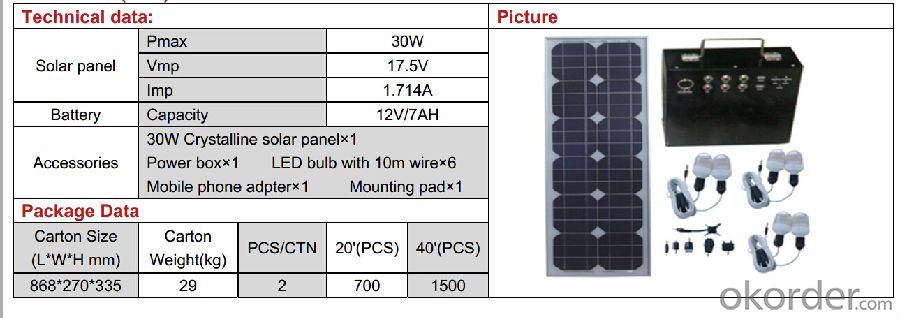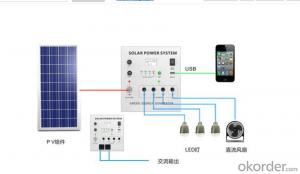solar system 30w which made in China
- Loading Port:
- China Main Port
- Payment Terms:
- TT OR LC
- Min Order Qty:
- -
- Supply Capability:
- -
OKorder Service Pledge
Quality Product, Order Online Tracking, Timely Delivery
OKorder Financial Service
Credit Rating, Credit Services, Credit Purchasing
You Might Also Like

- Q:How does the angle and orientation of solar panels affect their performance?
- The angle and orientation of solar panels greatly impact their performance. The angle determines how effectively the panels can capture sunlight, while the orientation determines the direction in which they face. Optimal angles and orientations maximize the panels' exposure to sunlight, resulting in increased energy production.
- Q:How do solar energy systems affect carbon footprint?
- Solar energy systems have a positive impact on carbon footprint as they harness the power of the sun, a renewable and clean energy source, to generate electricity. By reducing reliance on fossil fuels, solar energy systems significantly decrease carbon dioxide emissions and other greenhouse gases, thereby helping to mitigate climate change and reduce our overall carbon footprint.
- Q:Can a solar energy system be installed on commercial buildings?
- Solar energy systems can indeed be installed on commercial buildings, with many already adopting this sustainable method of generating electricity. Commercial buildings offer ample rooftop space or open land areas where solar panels can be installed. These panels can be seamlessly incorporated into the building's design or mounted on the rooftop, effectively harnessing sunlight and converting it into usable energy. The installation of a solar energy system on a commercial building brings numerous benefits. Firstly, it significantly reduces energy costs, as solar energy is both renewable and cost-free. Secondly, it serves as a clean and eco-friendly alternative to traditional energy sources, effectively reducing the building's carbon footprint. Moreover, commercial buildings with solar panels can take advantage of various government incentives and tax credits that encourage the use of renewable energy. Ultimately, the installation of a solar energy system on commercial buildings is not only feasible but also financially and environmentally advantageous.
- Q:What is the impact of temperature on the efficiency of a solar energy system?
- The temperature greatly affects the efficiency of a solar energy system. As the temperature rises, the efficiency of solar panels decreases. This is because of how the semiconductor materials used in solar cells behave. When solar panels are exposed to sunlight, they absorb photons and convert them into electricity. However, as the temperature increases, the resistance of the semiconductor material also increases, which leads to a decrease in the flow of current. This phenomenon is called the temperature coefficient of power. The temperature coefficient of power is usually expressed as a percentage per degree Celsius and varies depending on the type of solar panel technology. Most solar panels have a negative temperature coefficient, meaning their efficiency decreases as the temperature rises. On average, solar panel efficiency can decrease by around 0.5% to 0.8% for every degree Celsius increase in temperature. Moreover, increased temperatures can cause thermal losses within the system. The heat can accumulate in the solar panels, further reducing their efficiency. This is particularly true in hot climates or when there is high solar irradiance. To address the impact of temperature on solar energy system efficiency, various strategies can be employed. One common approach is to incorporate cooling mechanisms, such as ventilation or water circulation, to dissipate the excess heat generated by the solar panels. This helps maintain lower operating temperatures and consequently improves overall efficiency. Furthermore, proper system design and installation techniques can also reduce temperature-related losses. For instance, mounting solar panels with sufficient spacing to allow for air circulation can prevent overheating. Additionally, choosing solar panels with lower temperature coefficients can help minimize efficiency losses in high-temperature environments. In conclusion, temperature significantly affects the efficiency of a solar energy system. Higher temperatures can cause a decrease in solar panel efficiency, mainly due to increased resistance in the semiconductor materials. To optimize the performance of solar energy systems, strategies like cooling mechanisms and proper system design should be implemented.
- Q:How do solar energy systems contribute to reducing the need for new power plant construction?
- Solar energy systems contribute to reducing the need for new power plant construction by providing a clean and renewable source of electricity. By harnessing the power of the sun, solar energy systems produce electricity without emitting harmful greenhouse gases or pollutants like traditional power plants. This reduces the overall demand for electricity from fossil fuel-based power plants, thereby reducing the need for new power plant construction. Additionally, solar energy systems can be installed on rooftops, unused land, or integrated into buildings, making them versatile and minimizing the need for large-scale power plant infrastructure.
- Q:Can solar energy systems be installed in areas with high winds?
- Solar energy systems are indeed capable of being installed in areas that experience strong winds. The consideration of wind speeds during the installation of solar panels is vital to guarantee their durability and longevity. These panels are specifically engineered to endure various weather conditions, including gusty winds. By implementing robust mounting systems and utilizing suitable fasteners, their ability to resist wind damage can be further reinforced. Furthermore, certain manufacturers subject their solar panels to rigorous testing procedures to ensure they can withstand high wind speeds. It is highly advisable to seek the guidance of a professional installer who can evaluate the unique conditions of the location and develop a solar energy system that can effectively endure strong winds.
- Q:Can solar energy systems be used in areas with frequent power outages?
- Yes, solar energy systems can be used in areas with frequent power outages. Solar panels generate electricity from sunlight, which means they can provide a reliable source of power even during outages. Additionally, solar energy systems can be combined with battery storage systems, allowing excess energy produced during the day to be stored and used during nighttime or when the sun is not shining. This helps ensure a continuous power supply, making solar energy a viable and sustainable solution for areas with frequent power outages.
- Q:How does the angle of a solar panel affect its performance in different seasons?
- The angle of a solar panel plays a crucial role in determining its performance in different seasons. The angle, also known as the tilt or inclination, refers to the angle at which the solar panel is positioned relative to the ground. In general, the optimal angle of a solar panel varies depending on the geographical location and the time of year. In regions closer to the equator, where the sun is more directly overhead throughout the year, the optimal angle is usually closer to 0 degrees (horizontal) or a slight tilt towards the equator. During the summer solstice, when the sun is at its highest point in the sky, a solar panel with an optimal tilt angle will receive maximum sunlight and achieve peak performance. This is because the sun's rays are more perpendicular to the panel's surface, resulting in higher solar energy absorption. In contrast, during the winter solstice, the sun is at a lower angle in the sky, resulting in less direct sunlight. In this scenario, a solar panel with a steeper tilt angle can help capture more sunlight by ensuring that the panel is more perpendicular to the sun's rays. By adjusting the angle to be more vertical, the panel can maximize its exposure to sunlight and maintain a higher level of performance. In regions with distinct seasonal changes, it may be beneficial to utilize an adjustable mounting system that allows for the optimization of the solar panel's angle throughout the year. This enables the panel to be tilted towards the optimal angle for each season, ensuring a more consistent and efficient energy generation. However, it's important to note that the performance of a solar panel is influenced by various factors other than just the angle, including weather conditions, shading, and the efficiency of the solar cells themselves. Therefore, while the angle is a crucial factor to consider, it should be taken into account alongside other parameters when designing an effective solar power system.
- Q:Can solar energy systems be used in powering printing presses or publishing houses?
- Yes, solar energy systems can be used to power printing presses or publishing houses. Solar panels can generate electricity from sunlight, which can be used to power the various equipment and machinery required in printing or publishing processes. Additionally, solar energy systems can help reduce electricity costs and environmental impact, making them a sustainable and viable option for powering these operations.
- Q:Can solar energy systems be used in areas with strict noise regulations?
- Yes, solar energy systems can be used in areas with strict noise regulations. Unlike traditional power generation methods such as diesel generators or wind turbines, solar energy systems operate silently as they convert sunlight into electricity. This makes them an ideal choice for areas with noise restrictions, ensuring compliance with regulations while still harnessing clean and renewable energy.
1. Manufacturer Overview |
|
|---|---|
| Location | |
| Year Established | |
| Annual Output Value | |
| Main Markets | |
| Company Certifications | |
2. Manufacturer Certificates |
|
|---|---|
| a) Certification Name | |
| Range | |
| Reference | |
| Validity Period | |
3. Manufacturer Capability |
|
|---|---|
| a)Trade Capacity | |
| Nearest Port | |
| Export Percentage | |
| No.of Employees in Trade Department | |
| Language Spoken: | |
| b)Factory Information | |
| Factory Size: | |
| No. of Production Lines | |
| Contract Manufacturing | |
| Product Price Range | |
Send your message to us
solar system 30w which made in China
- Loading Port:
- China Main Port
- Payment Terms:
- TT OR LC
- Min Order Qty:
- -
- Supply Capability:
- -
OKorder Service Pledge
Quality Product, Order Online Tracking, Timely Delivery
OKorder Financial Service
Credit Rating, Credit Services, Credit Purchasing
Similar products
New products
Hot products
Hot Searches
Related keywords


























